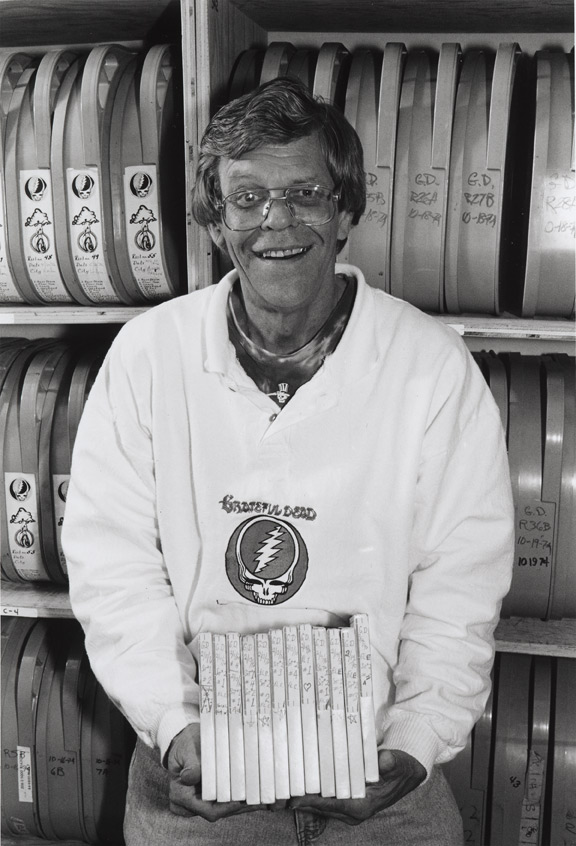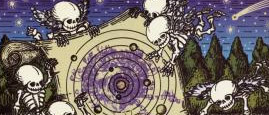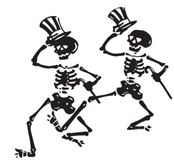By Nicholas Meriwether
The Dick Latvala Collection
This week’s entry focuses on another major supporting collection in the Grateful Dead Archive, the Dick Latvala Collection. Latvala (1943–1999) is known to most fans as the namesake of the Dick’s Picks series of two-track Vault releases, which commenced in 1993 and spanned 36 releases, ending in 2005. Latvala’s collection is divided into two major sections, or series, as archivists call them: his personal collection of tapes, more than 500 seven-inch and ten-inch reels, and his papers, which comprise more than a dozen linear feet of notebooks, correspondence, and other materials. There is also a wonderful piece of realia: his beloved reel-to-reel tape recorder, with a Steallie prominently attached to the front.
One of the Archive’s first supporting collections, the Latvala archive was given to UC Santa Cruz by Latvala’s wife Carol and son Rich shortly after the Dead donated their archive to the university. The gift was an effort led by Dennis McNally, who recruited the support of several donors, all of whom agreed that the collection should be preserved as part of the larger story of the Dead. The generosity and thoughtfulness of the gift make the collection even more of an expression of the ideals and the community that defined the Grateful Dead phenomenon.
One of the least extensive but most evocative parts of the collection is a small box containing Latvala’s notebooks. Starting in the 1970s, Latvala began to catalog his tapes in a series of notebooks, detailing their origin and provenance—who taped it and with what equipment—as well as when, where, what they played. He usually noted especially strong renditions as well as his impressions, which he would often revisit later, critiquing his critiques. Sometimes his estimation changed for the better, sometimes for the worse; some of the most compelling entries are those where he confirmed and underscored his first impressions. When he first listened to an audience recording of the legendary Cornell ’77 show, only a few weeks after the concert, he wrote, “After a few hearings I remain pretty convinced that this is the best show I’ve yet heard from the 1977 tour. Of course, there are shows where they excel on some of the above tunes, but overall, I haven’t heard a finer show.” Six years later he revisited the tape and emphasized, “Enough can’t be said about this superb show.” The conscientiousness and insight of those reviews helps to explain why he would be tapped as the first Vault archivist.
There are also some letters and press clippings in the collection—even a few wonderfully decorated envelopes—but the bulk of the papers are print-outs of conversations and posts in various Dead-related online forums, where Latvala debated the merits of various performances and solicited others’ opinions about which shows were significant and why. His extensive annotations—long comments and responses, written between lines and in the margins—make what might otherwise be a difficult series, from an archival and scholarly standpoint, absolutely compelling. Though not yet fully processed, already Latvala’s papers make clear how thoughtful he was in choosing releases, and how he disciplined his passion with the studiousness and rigor that he believed the subject demanded. That was what ultimately earned him the job of organizing the Vault and shepherding its historic two-track recordings to the public: that knowledge, passion, and critical acumen.
All of which shows in the tapes. The reels are remarkable for their extensiveness and organization, graphic proof of both the effort expended, and the potential glimpsed, by even the first generation of Deadhead tape traders. Latvala’s aggregation of hundreds of reels of carefully labeled, annotated tapes is not only graphic testament to the labor and time required to build a Deadhead tape collection, but also to the remarkable aural history that could result. As a collection, it is a document of community as well, the expression of a network of relationships, built on trust and respect—effort that now seems impossibly foreign in an era of readily shared digital files.
The seismic changes wrought by the age of the Internet and the advent of digital audio make the Latvala Collection all the more significant. Those early tapes are integral to understanding how the Dead phenomenon took root. Taping shows how the band’s commitment to excellence translated into the audience. Most rock bands were not worth recording in concert, the sound was so poor. The Dead not only rewarded taping—and listening—with the finest concert sound, they encouraged it by never repeating a show. Though some early set lists didn’t vary as widely as later ones, they never sounded the same. Every song represented a chance for the band to embrace the ancient artistic imperative to “make it new,” an opportunity they embraced as a defining moment, every time.
The excellence of the PA challenged tapers to become expert field engineers, and Deadheads responded with enthusiasm, over time developing sophisticated concert rigs that could produce professional results. That professionalism extended to their collections, which tended to be neatly arranged, carefully documented—and often quite beautiful. Deadheads decorated their tape boxes, adding an illuminated quality to the sonic history they treasured. From an archival standpoint, those decorations are metadata as art. Latvala has only a few decorated reel boxes, but they are fine examples of this seminal Deadhead artform.
Latvala’s collection makes a number of points, but three major themes stand out. The first is how porous the boundary between band and fan in the Grateful Dead phenomenon could be. Latvala dated his conversion to committed Deadhead to the Trips Festival in January 1966. Over time he befriended the crew, eventually going to work as a studio gofer and finally as the first Vault archivist, after completing the first major survey of its holdings. His hiring was part of a long tradition the band had of seeking out experts whose skills they needed, the counterpart of their belief that dedicated employees could also be encouraged to expand their skills to meet new challenges. It was an approach that instilled an astonishing level of dedication in their longtime staffers—and remarkably low turnover.
The second major theme that the Latvala Collection reveals is how participation in the Dead phenomenon instilled a sense of historicity in fans. Taping made every amateur recording engineer a historian of their own experiences; Bear even referred to his tapes as “sonic journals.” Tapers created the primary records of the Grateful Dead phenomenon, the concert tapes that were copied and traded and disseminated, bonding fans all over the world in an early social network, long before that term had even emerged.
Most of all, the collection Latvala built demonstrates that it is impossible to tell the story of the Dead without discussing their fans. Deadheads are not only an inextricable part of the phenomenon, they are a vital part of the Archive. That connection goes to the heart of what Latvala’s collection also says about the phenomenon, for Latvala made the transition from amateur to professional, from fan to insider, eventually earning a living from his passion for the band. His was not always an easy position to be in, by any means. Yet for Latvala, his work was something he believed in, a cause that could sustain him even when it felt as if the job fell short of those ideals.
Latvala died in 1999 at the age of 56 from a heart attack. His passing was widely mourned by Deadheads, not only for the passion and expertise he brought to the job but especially for his generosity. He never forgot he was a Deadhead, and it is interesting to note that several tapes elsewhere in the Archive bear the legend, “Courtesy of Dick Latvala. Do not circulate!” Deadhead writer Steve Silberman once memorably called Latvala a double agent, a tribute to the fact that he never forgot his roots as a fan, even though his primary responsibility had to shift to the band who employed him and trusted him to represent their music in the best light possible.
Latvala’s career and legacy demonstrate how powerful the link between band and fans could be, someone whose role and nature made him the second dedicatee of Dennis McNally’s authorized biography A Long Strange Trip, after Jerry Garcia. “There’s God and His chief discipine,” as McNally explained in an interview. Calling him “the ultimate true believer” in the Dead’s music, McNally gave Latvala one of his best descriptions in the book: “Baptized in the Fillmore, raised up in the Avalon, he’d washed his spirit in ‘Dark Star’ and pledged his soul to the cause.” Artist Anne Cutler’s memorial handbill for Latvala frames his life in classic San Francisco psychedelia, with Aoxomoxoa-style imagery and lettering. It is a reminder that Latvala was from that first generation of fans who saw the band in the glory days of the Haight, and never got off the bus. “I would like to experience life in a different way,” he wrote in a 1965 autobiographical essay. As his collection shows, he did.
Notes
Quotes are from Nicholas Meriwether, “Writing the Dead: An Interview with Dennis McNally,” Dead Letters Vol. 2 (Columbia, SC: Dead Letters, 2003): 56. Dennis McNally, A Long Strange Trip: The Inside History of the Grateful Dead (New York: Broadway Books, 2002), 606. Dick Latvala, “Autobiography,” May 9, 1965, 1. https://www.dicklatvala.com/autobio/autobio01.htm (May 13, 2015).
Illustrations
Fig. 1. Dick Latvala, by Susana Millman. © Susana Millman, all rights reserved. www.mamarazi.com. Courtesy Grateful Dead Archive, UC Santa Cruz.
Fig. 2. Technics Reel-to-Reel Tape Recorder. Dick Latvala Collection, UC Santa Cruz.
Fig.3. Dick Latvala, “May 8, 1977.” Notebook entry. Dick Latvala Collection, UC Santa Cruz.
Fig. 4. Decorated envelope, Dick Latvala Collection, UC Santa Cruz.
Fig. 5. Jerry Moore, Decorated tape box, Grateful Dead, Winterland, Oct. 18, 1974. Dick Latvala Collection, UC Santa Cruz.
Fig. 6. Anne Cutler, “Dick Latvala, 1943-1999,” 1999. Dick Latvala Collection, UC Santa Cruz.
dead comment
Dick Latvala Collection
Great collection and a nice tribute
bravo
Thank you, Dick! Those reels are rockin'
Awesome...
A request...











